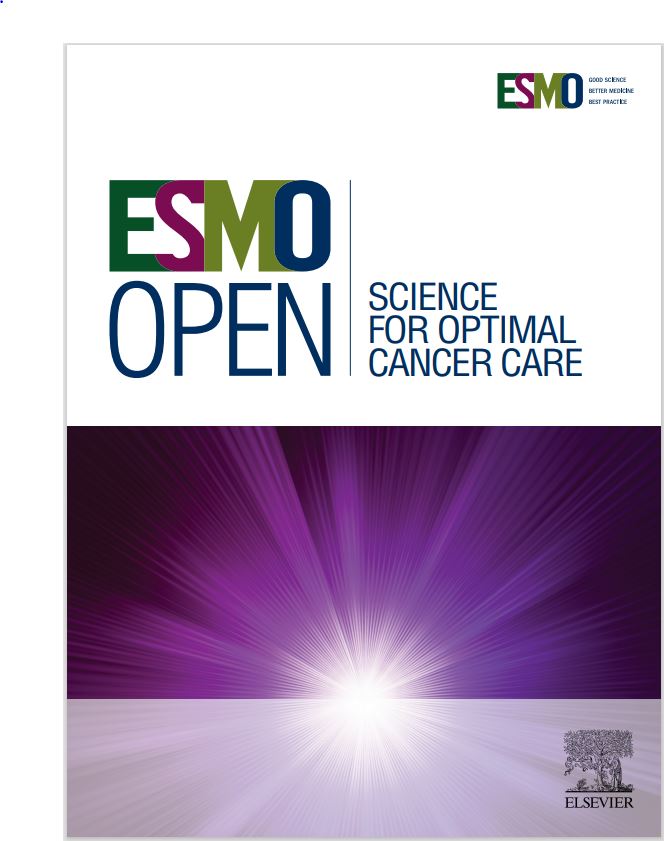使用avelumab、短期放疗和环磷酰胺治疗头颈癌的多模态免疫疗法:对抗I-II期试验
IF 7.1
2区 医学
Q1 ONCOLOGY
引用次数: 0
摘要
抑制程序性细胞死亡蛋白1 -程序性死亡配体1 (PD-1-PD-L1)轴可导致复发/转移性头颈部鳞状细胞癌的适度客观缓解率(ORR)。本研究旨在评估节拍化疗和单次放疗是否能与抗pd - l1治疗协同作用。患者和方法我们进行了一项I-II期研究,评估了avelumab(静脉注射10mg /kg,每2周一次)、低剂量环磷酰胺(50mg /天,固定剂量,不间断治疗)和单次放疗(8gy)对一个病灶的疗效。研究的第二阶段部分遵循Simon的两阶段优化设计。共有6名患者入组I期,20名患者在II期累积和分析,然后确定是否进展到II期(51名患者)。主要终点为ORR。此外,对一组循环细胞因子进行了分析,以探索潜在的毒性和/或疗效标记。结果在2019年1月至2020年6月期间,20名患者入组。在I期,6名患者中仅观察到1例剂量限制性毒性,允许进展到II期。在第一阶段结束时,记录了5个客观反应(2个完整反应和3个部分反应),未能达到拒绝零假设所需的6个反应的阈值。中位无进展生存期和总生存期分别为3.0个月和9.2个月。治疗耐受性良好。低基线水平的转化生长因子-β (TGF-β)和/或白细胞介素(IL)-4与免疫相关不良事件(irAEs)的高风险相关,而高基线水平的IL-6和血管内皮生长因子(VEGF)与不良结局相关。结论:在未选择的复发/转移性头颈癌患者队列中,我们的结果未达到拒绝原假设所需的ORR阈值。IL-6和VEGF与总生存率相关,而TGF-β和IL-4与irAEs相关。本文章由计算机程序翻译,如有差异,请以英文原文为准。
Multimodality immunotherapy with avelumab, short-course radiotherapy, and cyclophosphamide in head and neck cancer: the CONFRONT phase I-II trial
Background
Inhibition of the programmed cell death protein 1–programmed death-ligand 1 (PD-1–PD-L1) axis results in a modest objective response rate (ORR) in recurrent/metastatic head and neck squamous cell carcinoma. This study aimed to evaluate whether the addition of metronomic chemotherapy and a single fraction of radiotherapy could synergistically operate with anti-PD-L1 treatment.
Patients and methods
We conducted a phase I-II study evaluating avelumab (10 mg/kg intravenously every 2 weeks), low-dose cyclophosphamide (50 mg/day, fixed dose, without treatment breaks), and a single fraction of radiotherapy (8 Gy) to one lesion. The phase II portion of the study followed Simon’s two-stage optimal design. A total of 6 patients were enrolled in phase I, and 20 patients were accrued and analyzed in phase II before determining progression to the second stage (51 patients). The primary endpoint was ORR. Further, a panel of circulating cytokines was analyzed to explore potential toxicity and/or efficacy markers.
Results
Between January 2019 and June 2020, 20 patients were enrolled. In phase I, only one dose-limiting toxicity was observed among the six patients, allowing progression to phase II. At the end of stage I, five objective responses (2 complete responses and 3 partial responses) were recorded, failing to meet the threshold of six responses required to reject the null hypothesis. The median progression-free survival and overall survival were 3.0 and 9.2 months, respectively. Treatment was well tolerated. Low baseline levels of transforming growth factor-beta (TGF-β) and/or interleukin (IL)-4 were associated with a higher risk of immune-related adverse events (irAEs), whereas high baseline levels of IL-6 and vascular endothelial growth factor (VEGF) correlated with poor outcomes.
Conclusions
Our results did not achieve the ORR threshold required to reject the null hypothesis in this cohort of unselected patients with relapsed/metastatic head and neck cancer. IL-6 and VEGF were associated with overall survival, whereas TGF-β and IL-4 correlated with irAEs.
求助全文
通过发布文献求助,成功后即可免费获取论文全文。
去求助
来源期刊

ESMO Open
Medicine-Oncology
CiteScore
11.70
自引率
2.70%
发文量
255
审稿时长
10 weeks
期刊介绍:
ESMO Open is the online-only, open access journal of the European Society for Medical Oncology (ESMO). It is a peer-reviewed publication dedicated to sharing high-quality medical research and educational materials from various fields of oncology. The journal specifically focuses on showcasing innovative clinical and translational cancer research.
ESMO Open aims to publish a wide range of research articles covering all aspects of oncology, including experimental studies, translational research, diagnostic advancements, and therapeutic approaches. The content of the journal includes original research articles, insightful reviews, thought-provoking editorials, and correspondence. Moreover, the journal warmly welcomes the submission of phase I trials and meta-analyses. It also showcases reviews from significant ESMO conferences and meetings, as well as publishes important position statements on behalf of ESMO.
Overall, ESMO Open offers a platform for scientists, clinicians, and researchers in the field of oncology to share their valuable insights and contribute to advancing the understanding and treatment of cancer. The journal serves as a source of up-to-date information and fosters collaboration within the oncology community.
 求助内容:
求助内容: 应助结果提醒方式:
应助结果提醒方式:


